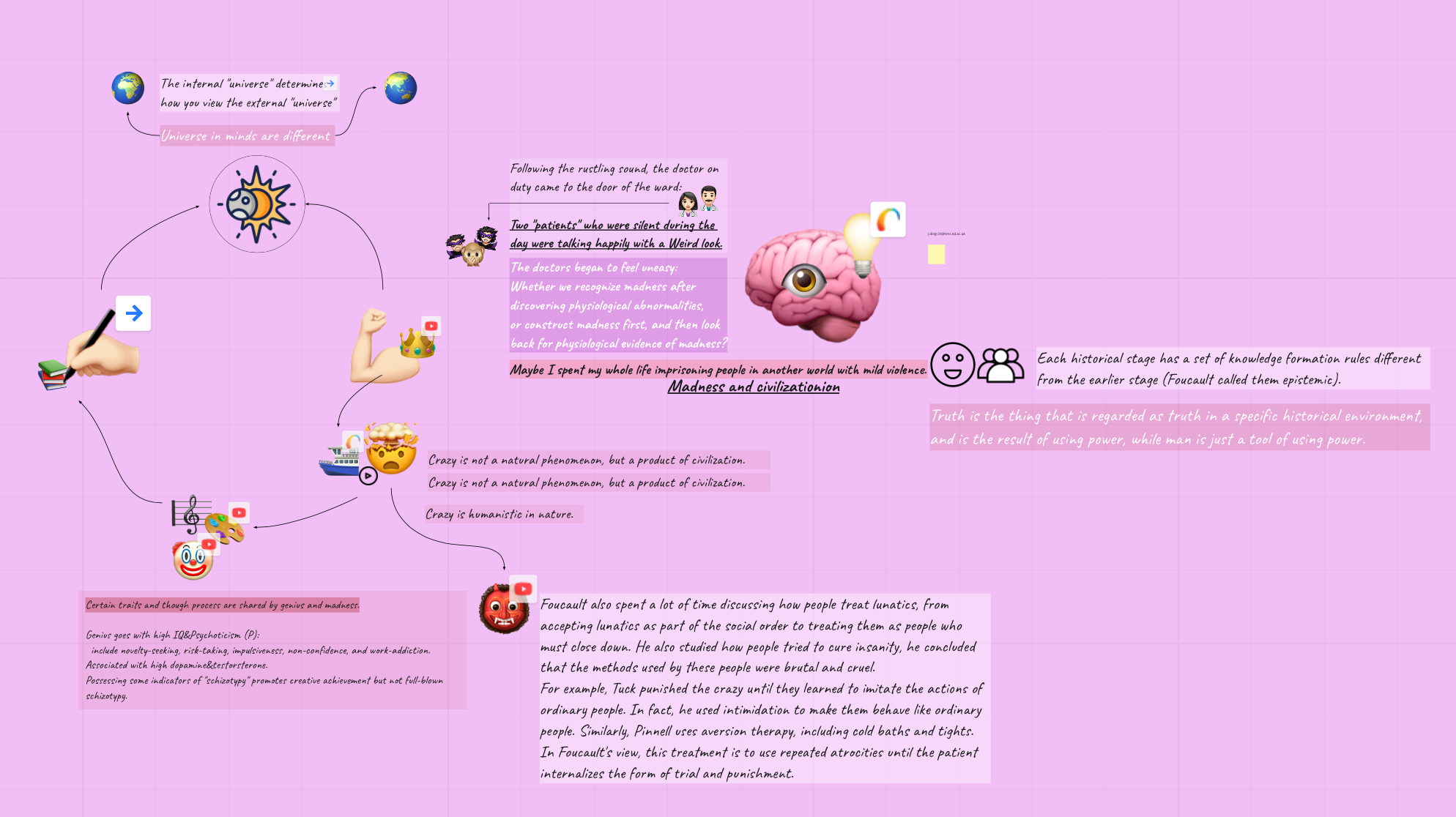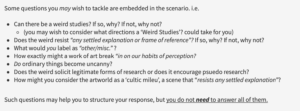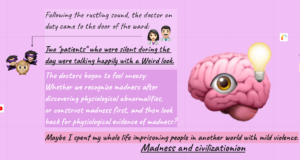Sprint1_Week2#Weird studies

The Problem Scenario:
‘”Weird Studies” is a scholarly field that doesn’t and can’t exist. The Weird is that which resists any settled explanation or frame of reference. It is the bulging file labelled “other/misc.” in our mental filing cabinet, full of supernatural entities, magical synchronicities, and occult rites. But it also appears when a work of art breaks in on our habits of perception and ordinary things become uncanny. ‘https://www.weirdstudies.com/about …’
-
First part-my weird method-About madness and civilization
It started with a story, a doctor found that: Tow “patients” who were silent during the day were talking happily with a Weird look. While they were silent in the day time. The doctor in the story is just like us, we always think we are the normal and the people with mental illness are the unnormal, but maybe we are wrong since the therapy of mental illness is just a mild way of violence to imprison them in another world.
There’s a process of my method:”The crazy” were diagnosed by anyone who had authority, then they was delivered to other countries or coasts by boat, which was called Das Narrenschiff.

Some of those died, but others created great poems, art works and music. But the authority tried to punished them because of their “weirdness”. For example, Tuck punished the crazy until they learned to imitate the actions of ordinary people. In fact, he used intimidation to make them behave like ordinary people. Similarly, Pinnell uses aversion therapy, including cold baths and tights. These treatments are to use repeated atrocities until the patient internalizes the form of trial and punishment. learnt from Foucault.
But they may ignored that: crazy is not a natural phenomenon, but a product of civilization, and crazy is humanistic in nature.
There also has some evidences about why the crazy are more creative and excited. Certain traits and though process are shared by genius and madness. Genius goes with high IQ&Psychoticism (P): include novelty-seeking, risk-taking, impulsiveness, non-confidence, and work-addiction. Associated with high dopamine&testorsterone. Possessing some indicators of “schizotypy” promotes creative achievement but not full-blown schizotypy.💡
After class, I finished the class assignment about creating a word which was called conlang. My conlang is: mad-geni-lization——madgenilization. Which was come from: madness, genius and civilization, as I stated above.
-
Second part-Some questions we may wish to tackle are embedded in the scenario

- Can there be a weird studies? If so, why? If not, why not?
- (you may wish to consider what directions a ‘Weird Studies’? could take for you)
- Does the weird resist “any settled explanation or frame of reference”? If so, why? If not, why not?
- What would you label as “other/misc.” ?
- How exactly might a work of art break “in on our habits of perception?
- Do ordinary things become uncanny?
- Does the weird solicit legitimate forms of research or does it encourage psuedo research?
- How might you consider the artworld as a ‘cultic mileu’, a scene that “resists any settled explanation”?
1/ Can there be a weird studies? If so, why? If not, why not?
I think there can be a Weird studies, as Foucault said that crazy is humanistic in nature. There are so many artists who we may think they are special or even crazy in our daily life, but they have actually created great art works in centuries. So I suppose there must be a specifical theory on studying their minds and the way they act instead of trying to “treat” them. That’s also the directions I’d like to focus on.
2/ Does the weird resist “any settled explanation or frame of reference”? If so, why? If not, why not?
Some times the answer maybe yes, but some times it should say no. In my opinion, weird doesn’t mean to resist anything or be totally opposite to the settled explanation or frame of reference. It’s just something unnormal in the world. Weird thing can be a tree in strange shape, a man act different as others, and anything probably will not take place on most of people. Everyone and everything live here for no reason, what’s more, they don’t need any reasons to proof the rationale for their existence and then follow the general trend.
In another word, Each historical stage has a set of knowledge formation rules different from the earlier stage (Foucault called them epistemic). And what we called settle explanation or the frame of reference is just the thing that is regarded as truth in a specific historical environment, and is the result of using power, while man is just a tool of using power.
3/ How exactly might a work of art break “in on our habits of perception?
First, we need to figure out what means our normal habits of perception. At the visual aspect, we always regard beautiful or unparalleled things as
4/ Does the weird solicit legitimate forms of research or does it encourage psuedo research?
-
Third part-Guided Apophenia: A Conspiracy Theory Workshop

To be honest, I’m a less imaginative person, but the process of creating the correlation arose my creativity. The workshop for us is creating a conspiracy theory of our own. Before we do that, our Professor showed us a video of a conspiracy in a website named Wayfair. It looked like a website that sold furniture, but it sold young child instead. They labeled the children and then sold them as they were just products. It was a huge and uncanny conspiracy!

Our yellow basho use the tool which named spurious correlation to find a direction which we are all interested in. Then we used the link from Professor Neil which was called comment picker, tried to invent some related words between the keywords we’ve found. After that, we needed to find some evidences to proof or support our topic in first step, we should collect some news about cheese consumption and people who died by becoming tangled in their bed sheets. Finally, we created the story that connected the science with the spurious correlation. The story was about a poor couple who lived in tunnel, one day after their sex, the man was fell asleep but he had allergic reaction to the cold air. So he tried his best to wrap the sheets tightly. But he thought it was not enough, and he started to eat cheese as more as possible since he wanted to awake his body to burn his calorie for keeping warm. The more he ate, the fatter he was. At last, he was died by becoming tangled in their bed sheets. And the cheese he stocked becoming a huge “cheese fire” then destroyed the tunnel!
Sounds crazy right? But actually, it is the real a conspiracy theory.
-
Fourth part-Additional Work
1/ Day 1 Suggested Reading: Weird Fiction Review.
I choose the fiction which named Red Rabbit, it tells a story about the weird woman Clara and the weird rabbits. Clara was considered mentally ill by Matt. They lived in a far countryside, which had a fenced yard. Clara always crazy yelled about bloody rabbits appeared again and again in their yard but Matt just thought she was crazy until Clara laid on their yard bloody without skin.
The story is a kind of weirdness, it shows something uncanny in our daily life. And it also stimulates people’s curiosity about the unknown, the mysterious and even the terrifying. I suppose that’s a part of how “the weird” worked.
2/ Day 2 Suggested Reading: Apophenia.
Apophenia is temporarily translated as associated disorder or associated disorder. Originally, in psychology, it refers to a tendency to think that the pattern of the question of seemingly unrelated things is meaningful, is closely related to cognitive style, which widely exists in human cognitive activities and is considered to be related to paranoia.
In the field of artificial intelligence, Apophenia phenomenon also exists at all levels, especially in the deep neural network media using unsupervised learning. In fact, Apophenia is also used as a wooden language to refer to program errors in the neural media, but these errors or defects have been utilized in artistic creation.
I selected the first dissertation as my preview reading. It states about the Visual Apophenia. The writer was absolutely unbelieving in ghost voice. But as he gradually sought relevant connections both internally and externally, he was starting to think the theory is plausible. Eventually he became one of the proponents of the theory.
So at last workshop, we exactly practiced how to create conspiracy theories with Apophenia’s point like the writer did about Ghost Voice.
3/ Post-Theme Diagnostic (link) Due End of Week 3
Already finished!





Jia Ding, this is a brilliant first blog post that is comprehensive in documenting and reporting on your activity during the first Sprint. Your reflective insights into what you’ve learnt during the process were thoughtful and demonstrated a decent level of engagement with and comprehension of key texts such as Foucalt related to the governmentality underpinning the distinction of ‘weird’. Try to include citations and full academic references for the resources you include in your posts whenever possible.
Thank you for using full resolution images from the miro board work you did, it was great to be able to read the images fully to seee where you have been cropping and using them. You structured your reflections in an accessible and interesting way that consistently made good use of the materials available and those you created during the sprint. Try not to denigrate your own creativity as there are many ways of being imaginative and creative, try reading this book for context https://discovered.ed.ac.uk/permalink/44UOE_INST/1viuo5v/cdi_informaworld_taylorfrancisbooks_9780203508527
“weird”
We always think we are normal and the patient is sick. In fact, it is a bit too extreme, the treatment of mental illness is just a soft violent way to imprison them in another world
1. madness is a branch of the evolutionary history of humanism figurative, able to see through the epitome of that era.
Creativity is common to both genius and madness, genius on the left and madness on the right.
The author believes that the definition and framework in a specific historical environment is the truth. The author emphasizes the tools to assist the artist in the creation of that era, which is more in line with the toolkit, but I think there is a slight deviation from the concept of truth in philosophy. Truth is the correct reflection of objective facts and their laws in the human consciousness, and it exists objectively. The “strangeness” we are studying is in creative thinking, which is different
It’s really fun that your Miro board is in the form of a story. I do agree with you that madness is a kind of human nature and we all think we are the normal person while others who holds different opinions are crazy. Therefore, madness, as a form of weirdness is definitely worth studying.
I also think that weird studies can exist and kind of in the same way of thinking. 😀 I would say that curiosity arouses people’s attention naturally, it’s another part of human nature, so weird studies will certainly exist.
Your blog is well structured, many works can be seen visually, with readings and citation. I wish I could be this organised.